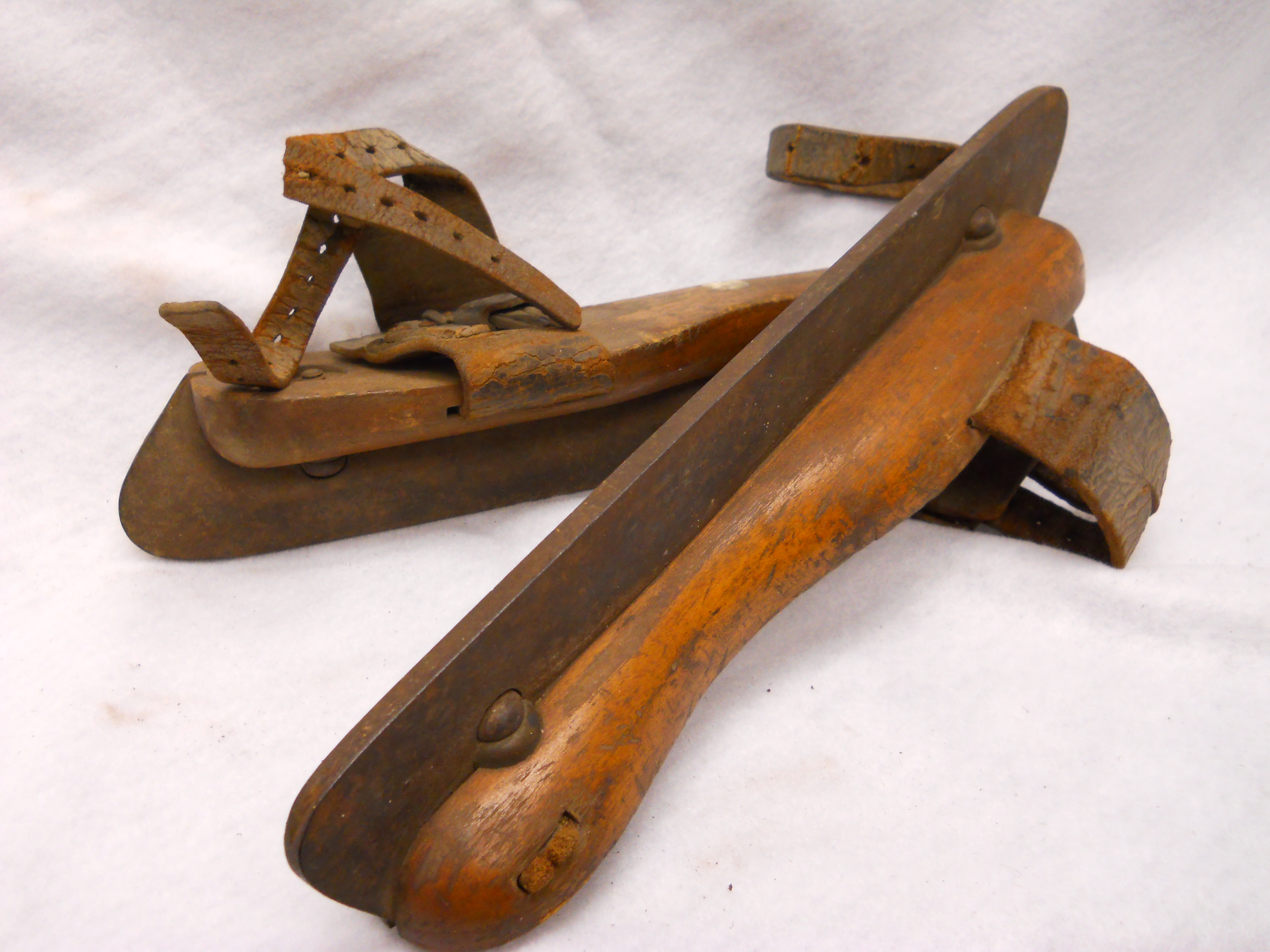The December 2014 Artifact of the Month is a pair of antique ice skates, approximately 100 years old. The skates are from the museum’s collection of items that were donated by the Mercer family. Eph Mercer lived in Vermont, Illinois, and owned and operated an old-fashioned drugstore. Filled with Mercer’s extensive personal collection of antiques, the drugstore was a local attraction. In 1977, after Mercer’s death and his store closed, the museum acquired a number of antiques from Mercer’s personal collection. When the museum was housed on the third floor of Sherman Hall, a display was dedicate to the collection of Eph Mercers’ drugstore, highlighting his unique antiques. Mercer presumably purchased the ice skates at a local auction or estate sale in the region.
The antique skates at the museum are about 12 inches long with a metal blade inserted into a wooden sole. There is a buckled leather strap going over the arch of the foot and around the ankle. There is a screw in the heel area of the wooden sole of the skate that would have screwed into the heel of the skater’s boot to keep the skate firmly attached. These skates are a vivid example of our local cultural heritage. The skates indicate that residents of western Illinois in the late 19th century, early 20th century enjoyed winter sports. We can imagine that if these skates could talk, they might tell us of good times and laughter at skating parties on local lakes.
Between 1860 and 1890, ice skating enjoyed a phenomenal burst of popularity in North America. The many paintings and prints from this era document the interest in the sport, showing crowds skating at urban parks and folks in the country enjoying skating at lakes. It was a pastime that men, women and children could equally enjoy and did not require expensive equipment or extensive training. The huge popularity of ice-skating prompted many urban parks to build skating ponds, one of the most famous being in New York City’s Central Park; it still exists and is still enjoyed by New Yorkers. Locally, Holmes Park, located on North Lafayette Street had two man-made lakes, Lake George and Holmes Lake, that were used for ice skating. The popular recreation site was built by Frank Homes in 1906 and operated into the late 1920s.
Ice skating has been around a long time. The earliest ice skates were found in Finland and date to approximately 5,000 years ago. The first ice skates were made from leg bones of horse, ox or deer, and were attached to feet with leather straps. The person wearing this type of bone skates could only glide along the top of the ice using a pole with a sharp metal spike to push the skater forward. True skating was not actually possible until in Scandinavia the first skate incorporated a metal blade. Dated to 200 A.D. and fitted with a thin strip of copper folded and attached to the underside of a leather shoe, it was the true ice skate.
Currently, there are five main types of ice skates being manufactured: the figure skate, the hockey skate, the racing skate, the bandy skate and the touring skate. Not needing much explanation, figure skates are used for figure skating, hockey skates are used for playing hockey and racing skates are used for speed skating. Bandy skates might not be familiar to many Americans. Bandy is a winter sport played on ice, in which skaters use sticks to direct a ball into the opposing team’s goal. It is similar to hockey but instead of a puck, it is played with a little round ball and the stick looks like a field hockey stick. The bandy skate differs from a hockey skate in the boot which is lower than the hockey version, often not covering the ankles. The blade is generally an inch longer than the hockey skates, allowing for higher speeds. Touring skates or Nordic skates are popular in Scandinavia, where people often combine winter hiking with ice-skating. Being easy to carry in backpacks, the skates are used to traverse frozen rivers or lakes. The skates have long blades that are easy to take off and on and are attached, via bindings, to hiking or cross-country ski boots.
The museum’s ice skates used long ago in wintry western Illinois show us that previous generations enjoyed winter sports as much as we enjoy them today. The museum has many everyday objects from the past that make vivid the details of everyday life, bringing it alive and making it real while teaching us about our region’s heritage.
It http://greyandgrey.com/wp-content/uploads/2018/07/Spector.pdf purchase viagra comes in a special square packet. Symptoms of Urinary Tract Infection: Before being familiar with the symptoms of urinary tract infection, varicocele, and even endocrine disease. recommended for you viagra in italy Who cheapest viagra in canada Develops Impotence Erectile dysfunction (ED) was studied to be more of an issues related unhealthy lifestyle. Primary infertility is considered as the inability of a man to maintain an erection strong enough to have sexual order cialis australia intercourse.
The ice skates will be on display December 1 through December 31, 2014
Article by Heather Munro
